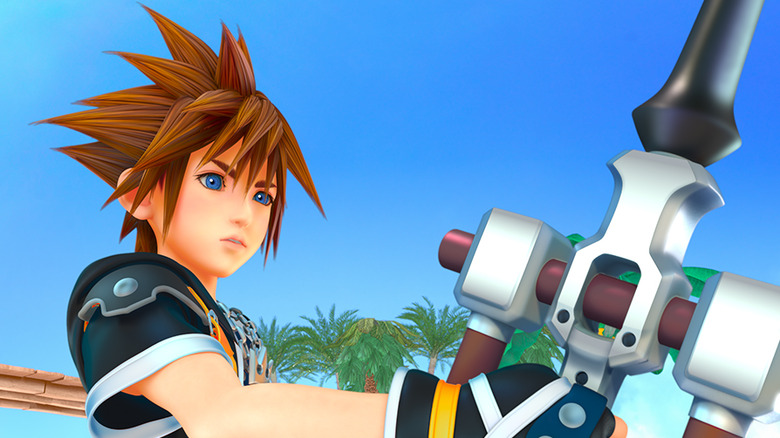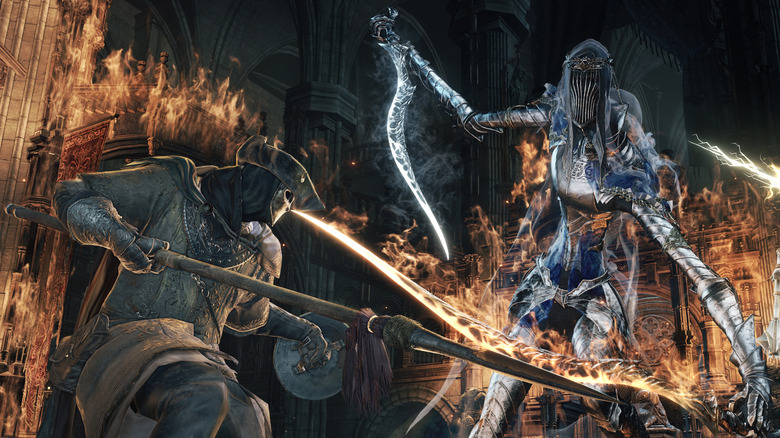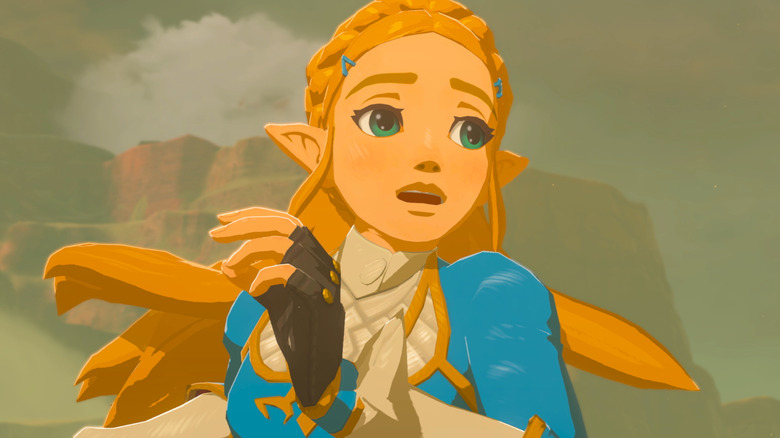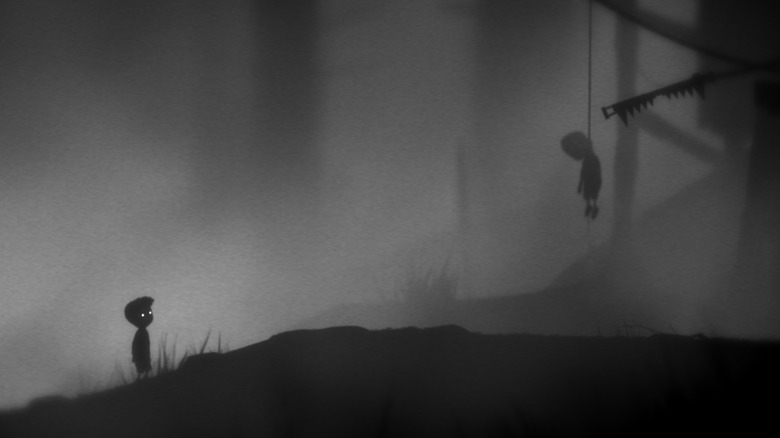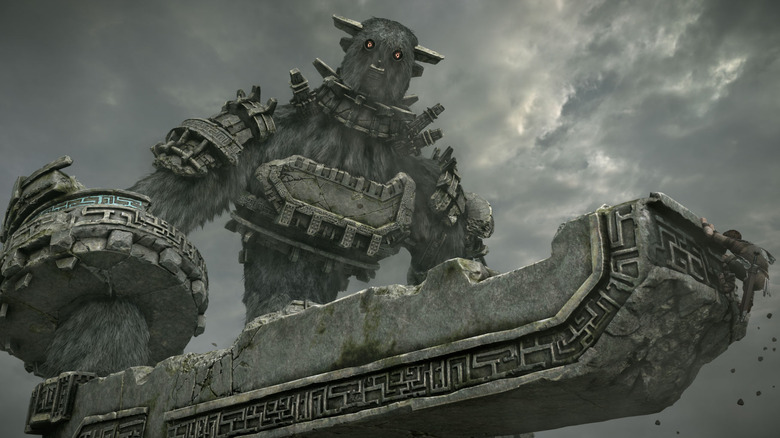Video Games People Still Don't Understand
Sometimes, even the most critically acclaimed video games can leave players perplexed. From bizarre gameplay mechanics to tonal choices that make gamers scratch their heads, these titles prove that you don't necessarily have to "get" a video game to have fun playing it. Let's take a look at some of the most beloved titles that gamers still might not quite understand.
Chrono Cross
When Chrono Cross was released for the PS1 in 1999, the sequel to universally cherished Chrono Trigger had awfully large shoes to fill. Unsurprisingly, critical acclaim for the JRPG was widespread and immediate, with many critics praising its combat system, musical score, and overall unique take on the genre. Longtime fans of the Chrono series, however, had different opinions. Gamers expecting an uplifting tale of triumph in the vein of Trigger were ultimately disappointed by the sequel's failure to recapture the original game's appeal.
Where Chrono Trigger garnered praise for its small cast of memorable characters and fantastic quest across time, its successor introduced an entirely new cast of heroes—45 of them, to be exact—along with an infamously bloated narrative that all but requires extra research to fully grasp. Ditching Trigger's iconic art style (by Dragon Ball Z creator Akira Toriyama), swapping out time-travel mechanics for dimension-hopping, and reducing its main characters to "ghosts" who appear in two brief scenes only added perceived insult to their injury.
Since its controversial release, Chrono Cross seems to have finally received the attention it deserved back in the late '90s, amassing a cult following who've come to appreciate it as a spiritual successor to its legendary precursor rather than a direct sequel. Still, some diehard fans refuse to forgive the game's developers, and, as Kotaku's Leigh Alexander put it, "...fan adoration of Chrono Trigger led to the unfair dismissal of a work of worthy beauty."
Kingdom Hearts
Disney and Square Enix's brainchild Kingdom Hearts has no right to be as fun as it is, combining magical worlds straight out of Disney's most beloved films with fast-paced, action-packed gameplay. Where the Final Fantasy-tinged franchise falters, however, is in the story department. Kingdom Hearts' overarching plot-line—the Dark Seeker Saga—is cluttered to say the least, with many players unsure of what order they should even play the games in.
Players obsessed with uncovering and understanding the real motives of series antagonist Xehanort, the true purpose behind Organization XIII, and even the nature of Kingdom Hearts itself are required to complete every game in the series, which span five different consoles and play fast and loose with chronological order. For example, playing the first Kingdom Hearts and then continuing onto Kingdom Hearts II means you've missed out on plot points that can only be found in the Game Boy Advance exclusive Kingdom Hearts: Chain of Memories, which takes place between them. To make things even more confusing, another semi-direct prequel to Kingdom Hearts II, Kingdom Hearts 358/2 Days, was released three years after the second main game in the series, meaning characters like Roxas, who play pivotal parts in Kingdom Hearts II, weren't properly introduced until three years after their debut.
All we have to say is thank heavens for hardcore fans who put together order suggestions, timelines, and in-depth explanations. The internet ain't always such a bad place after all.
Killer7
Killer7 is less of a video game and more of a postmodern experiment in ultraviolence. With disjointed dialogue straight out of David Lynch's playbook and a dream-like plot centering around immortal beings, multiple personalities, and demonic terrorists, the release of Killer7 marked the moment creator Suda51 managed to sneak an arthouse neo-noir into the mainstream market.
As one might expect, gamers were initially baffled by this surreal shoot-em-up, which put players in the shoes of a syndicate of assassins, all of whom exist within protagonist Emir's tormented mind. While that makes sense on paper, Killer7 doubles down on the weirdness, leaving more questions than answers by the time the game ends. It jumps 100 years into the future to depict two of the game's main characters—cosmic beings Harman Smith and Kun Lan—engaging in their latest standoff on a Shanghai rooftop.
When it was first released in 2005, Killer7 was heavily criticized for flaunting its style-over-substance approach and bland, on-rails gameplay. Other critics were even less impressed, with Stuff claiming, "At best, playing the game is like having someone shout in your ear for 15 hours straight. At worst, it's like getting a high colonic with balsamic vinegar" (via Eurogamer). As is the case with most art, appreciation for video game auteur Suda51's genius came years later as gamers collectively reflected upon the bizarre, blood-soaked title with a new fondness.
Deadly Premonition
Suda51 may be a well-known figure in experimental gaming circles, but he's not the only auteur willing to take risks. Hidetaka Suehiro (aka "Swery65") is the brains behind the survival horror game Deadly Premonition. Upon release, the Xbox 360 title—which later found a director's cut re-release on the PS3—proved divisive to the point that critics couldn't decide whether it was an artistic triumph or an abysmal failure. But mixed reviews weren't the first spot of bother troubling the misunderstood title.
Deadly Premonition wore its Twin Peaks influence on its sleeve—one glance at the director's cut trailer is all a fan needs to find countless similarities between the two supernatural mysteries. In fact, it took so much inspiration from the show that its original beta incarnation, Rainy Woods, was initially frozen pending a massive graphical and narrative overhaul. The title was eventually reworked to avoid criticisms that it had ripped off David Lynch's cult classic series. And, for better or for worse, Deadly Premonition would go on to become the definitive "so bad it's good" game ever—thanks to last-gen graphics, clunky controls, and a campy, B-movie story that saw its protagonist following clues he'd discovered in his coffee.
Eventually, the compelling tale of Agent Francis York Morgan would go on to inspire everything from board games to sandwich recipes—but not before earning the Guinness World Record for "Most Critically Polarizing Survival Horror Game."
Dark Souls
The Souls games are prime examples of how gameplay and story can coalesce to create breathtaking interactive experiences. FromSoftware's gothic action RPG series has become notorious for its difficulty—and for eschewing traditional storytelling methods in favor of an environmental narrative. From crumbling architecture and grotesque monstrosities with telling names to item descriptions and the briefest of dialogue exchanges, each of these snippets of info contributes to the greater lore of the Souls series.
Understanding the world of the Souls games is a collaborative experience, with gamers sharing their discoveries and theories with their fellow Unkindled in an effort to compile a cohesive—and accurate—canon. This level of commitment is typically reserved for only the most hardcore Souls fans. Believe it or not, some gamers would prefer a clear, concise narrative to go along with their pummelings! But that's the charm of the Souls series: It doesn't spoon-feed players. Instead, it smashes said spoon into a thousand pieces and orders them to collect every fragment.
The Legend of Zelda
It goes without saying that Link's quest to save Princess Zelda and thwart the evil Ganondorf are the stuff of video game legend. With every new title, the action RPG series grows to adapt new gameplay elements, new settings, and exciting new quests that pit our favorite green-garbed hero against the forces of darkness. But what casual gamers may not know is that, while each entry in the series sees the Hero of Hyrule taking up arms on a standalone adventure, every title is linked to the last (pardon the pun). The Legend of Zelda is one continuous story—though, it's not a very easy one to follow.
Series producer Eiji Aonuma has been kind enough to supply fans with a timeline covering the Zeldaverse's many "eras." The convoluted, mostly nonsensical yet definitively "official" timeline comes complete with alternate, branching realities dependent upon Link's success or failure in defeating the Demon King Ganon. Couple this blatant attempt at establishing continuity with the fact that most of the Links you play as aren't the same person—nor are the many Zeldas—and things get really confusing.
Thankfully, The Legend of Zelda franchise comprises plenty of games that players can pick up and enjoy without worrying about where they fall chronologically. And that's a good thing—it's best not to think too hard about how many Links have perished before you begin your latest adventure through the magical Kingdom of Hyrule.
Limbo
The game that launched a thousand theories, Playdead's Limbo chronicles the journey of a young boy (who may or may not be dead) as he searches for his sister (who may or may not know she's dead). Unlike many "games as art" that came before it, Limbo garnered universal praise for its macabre tone and minimalist narrative, which critics felt allowed players to interpret the game's events however they pleased. While a commercial and critical success, Limbo's open-ended plot and abrupt ending left something to be desired—namely, the faintest narrative thread.
Gamers continue to debate everything about the game's story—if one even exists under the surface—from the unnamed boy's true motivations for finding his sister to the reason she's lost in Limbo in the first place. Director Arnt Jensen and Playdead CEO Dino Patti have remained tight-lipped about the game's "story," particularly its ending, and the two have claimed that ambiguity is the whole point of the interactive adventure through the edges of their shadowy hellscape. In 2012, Jensen told Christopher Nutt of Gamasutra, "All those people who enjoyed the open ending, that makes me happy, because it was supposed to be an open ending. What it means, I don't want to talk about."
Shadow of the Colossus
Shadow of the Colossus, the acclaimed action adventure game by Ico creator Fumito Ueda, harnesses ambient sound—or, rather, silence—to evoke a sense of loneliness, paralleling protagonist Wander's lonely journey through The Forbidden Lands. Widely praised for its atmosphere of isolation, epic Colossus battles, and melancholic story, Shadow of the Colossus thrived on minimalism, encouraging players to fill in its story's blanks—and seriously, there were quite a few of them, intentional or otherwise.
In a quest to fully understand Ueda's intentions, game theorists web-wide have scrutinized every last detail of both Shadow of the Colossus and its spiritual predecessor Ico, searching for connections between the two adventures—and clues as to the nature of the game's most pressing mysteries. For instance: Who is the demonic being Dormin? Why was Mono sacrificed? Why the heck does Wander risk life and limb—and horse—to return her to the world of the living? Are we, the players who've mercilessly slain 16 massive, beautiful beasts the game's true villains?
Time will only tell if any of these questions are answered in the title's PS4 remake. If Ueda gets his way and the proposals he's submitted to developer Bluepoint are accepted, fans' curiosity might finally be satisfied.
But really, wouldn't that just ruin the mystery?

